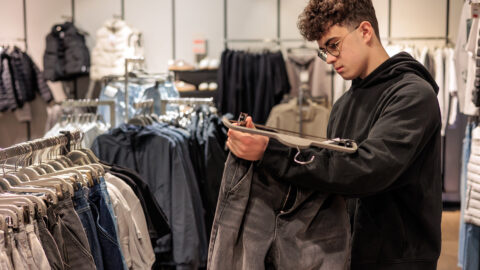Following is Part 2 of the Retail TouchPoints series focused on Analyzing The Omnichannel Consumer. In this article, innovative retailers share their strategies for connecting the communication and commerce dots across channels, leading to more seamless brand experiences. Complete the form below to access a PDF version of the full report.
Today it is commonplace for hyper-connected consumers to use multiple channels and technologies to browse and buy. Consumer research from Google confirmed this transition to omnichannel processes: 90% of survey respondents said they consulted multiple screens sequentially to accomplish tasks, while 98% said they moved between devices in the same day.
Retailers are acknowledging the ever-presence of these omnichannel consumers, and their overall impact on the bottom line. A study released by Retail Systems Research (RSR), titled: Omni-Channel 2012: Cross-Channel Comes Of Age, revealed that 38% of retailers believe cross-channel shoppers are significantly more profitable than single-channel shoppers.
The study noted that 79% of retailers believe that it is important for consumers to be able to complete their shopping transactions through their channel of choice, in order to maximize customer loyalty. Additionally, 79% thought it was imperative that they create a single brand identity across channels.
To enable more unified and fluid retail experiences across digital and physical channels, best-in-class retailers increasingly are investing in new solutions that target specific channels and industries, for e-Commerce sites, brick-and-mortar stores, and even for mobile devices and social media.
Loehmann’s Connects Online And In-Store Channels
Since its inception in 1921, Loehmann’s has strived to make shoppers feel they are receiving one-of-a-kind deals on designer goods. To keep pace with competitors and better connect with omnichannel consumers, the merchant sought to enable seamless experiences between the web, mobile and all 40 brick-and-mortar locations nationwide.
Loehmann’s successfully made this transition by replacing complex legacy systems with an online storefront that aligned seamlessly with the brick-and-mortar business. The new web site was launched in partnership with ShopVisible, a cloud-based e-Commerce solution provider.
“Our consumers love Loehmann’s because we provide access to great fashions at discount prices, no matter what channels they use to shop with us,” said Dan Sackrowitz, VP of e-Commerce at Loehmann’s, in an interview with Retail TouchPoints. “So in essence, all our consumers virtually are ‘omnichannel,’ and expect the same positive and seamless experiences from our brand.”
To enable compelling omnichannel customer interactions, the Loehmann’s e-Commerce site now features mobile and social commerce tools and capabilities, and enables flexible delivery and return options. Additionally, the CRM system is fully integrated with the e-Commerce site, which allows Loehmann’s Insider Club loyalty program members to access the same benefits in-store and online.
Consistent communication and coordination are essential in keeping omnichannel strategies up-to-date across the organization, Sackrowitz noted. Ongoing collaboration helps team members “ensure we give our shoppers what they want across all touch points. Omnichannel doesn’t live in one place within our organization. We work across teams to deliver the Loehmann’s brand experience that our customers expect.”
Canadian Tire Revises Internal Processes To Meet Omnichannel Expectations
Canadian Tire also strived to connect the dots across digital and physical touch points and in turn, create more compelling and relevant brand experiences. The big box retailer, which has been in business for more than 90 years, currently is working toward improving collaboration across mobile, social, online and in-store technologies such as self-serve kiosks, according to Rosie Riolino-Serpa, AVP of Digital at Canadian Tire.
“We’re focusing on many different components to improve the omnichannel experience, but we’re not going to introduce a new strategy until it’s very relevant to customers,” Riolino-Serpa said in an interview with Retail TouchPoints. “If an approach is not consistent across all the touch points then we won’t pursue it.”
Riolino-Serpa added that because Canadian Tire has so many different divisions, the company has to focus on corporate alignment and collaboration to guarantee all content and campaigns are consistent across all digital channels and brick-and-mortar locations. To that end, company team members meet regularly — either bi-weekly or monthly — “to ensure we have ongoing communication around omnichannel initiatives,” she explained. “For example, we need to verify that all employees are trained to respond to questions and concerns they receive across the call center, social media and email.”
Moreover, Canadian Tire collects and analyzes data across channels to streamline understanding of target customers, the products/services they’re seeking across channels and most importantly, deliver more relevant messages across channels based on those browsing and buying behaviors.
{loadposition MWIAA} “Our goal is to connect all data points to create cohesive customer profiles and enable those more relevant marketing messages and offers,” Riolino-Serpa said. “We want to show customers that we know the life they’re living and are here to help them in any way. For example, one area of Canada can be snowing while another area is sunny, so we consistently have to ask ourselves how to market to all these geographic areas effectively across all channels.”
In addition to better personalizing offers and content distributed online and via mobile, Canadian Tire is honing in on integrating technology into brick-and-mortar environments to make customer interactions more information rich and rewarding. In one example, the retailer is considering how consumers’ mobile devices, social media and in-store kiosks can add extra value to the in-store shopping journey.
“Right now we’re focusing on the customer experience and how digital will empower consumers to make more educated decisions in stores,” Riolino-Serpa stated. QR codes also will be another area of interest and investment, largely because they are effective gateways for consumers to obtain more detailed product information, as well as peer ratings/reviews.”
Aeropostale Integrates Digital Content And The Brick-And-Mortar Store
Loehmann’s and Canadian Tire are focusing on internal processes and implementing new technology to adapt to omnichannel trends. In a different approach, retailers such as Aeropostale have honed in on customer-centricity as the core of omnichannel business decisions, and are harnessing digital tools and tactics to complement new engagement and marketing trends.
Aeropostale team members “aren’t fazed by buzzwords such as omnichannel,” according to Anthony McLoughlin, past Senior Director of Interactive Marketing at Aeropostale, largely because the organization already is tightly integrated across departments. (At press time, McLoughlin had taken a position at bebe as VP of Interactive Marketing.)
“Aeropostale doesn’t really look at strategies as ‘omnichannel,’ but rather, ‘customer first,’” McLoughlin said, noting that the retailer’s target audience is the teen market. “We focus on catering to customers’ needs rather than having our shoppers follow us.”
Currently, mobile is a central part of Aeropostale engagement strategies; as many as 60% of all brand emails currently are opened and read on mobile devices, McLoughlin reported. Moreover, approximately 8% of all Aeropostale online sales and 30% of traffic derive from smartphones, while 7% of online sales and traffic come from tablets.
To continuously evaluate and determine the most effective features and capabilities to include in the mobile strategy, Aeropostale team members collect qualitative and quantitative insights and analyze consumer data extensively.
“We rely heavily on customer surveys, questionnaires and focus groups to better understand, right from their mouths, what our shoppers are expecting,” McLoughlin said. “This process helps us define the brand and scope of the strategy. For example, when it comes to mobile, everyone in the organization has an opinion, but in order to make concrete decisions, we always go back to what the teens are telling us.” As a result of data gathered, Aeropostale is focusing on refining the current iPhone app, releasing an Android app and developing web and app strategies for tablets.
In another example, Aeropostale successfully listened and responded to shoppers by developing a new concept store with Usablenet, a multichannel technology and solution provider. The store was unveiled at the Roosevelt Field Mall in Garden City, Long Island, on Oct. 19, 2012. The brick-and-mortar location incorporates four self-serve, iPad kiosks strategically placed throughout the store. Shoppers can use these devices to build their own outfits then email creations to friends, family and themselves. The devices also can be used to browse and buy on the mobile-optimized e-Commerce site, scan in-store bar codes to learn more about items, read reviews and receive complementary product recommendations.
“We want to be a part of the conversations our target audience has online, via mobile devices and in stores,” McLoughlin said in a previous interview with Retail TouchPoints. “We also want to create relevant brand experiences for our customers: that’s the vision at the core of this concept. To have that pertinent and emotional impact on teens, we needed to create a strategy and use technology that allows them to engage with us on their terms. We’re not just using tactics to drive sales; we’re using strategies that are consumer-centric to drive engagement and eventually create brand ambassadors.”
Due to the success of the Roosevelt Field Mall location, Aeropostale is expanding the strategy to more stores, McLoughlin explained. Now with more than 1,000 stores nationwide, the retailer will participate in a “sizable” rollout. “We’re working on a complete store redesign, with the tablet kiosk concept as a key component. Up to one-third of our stores may have this technology, but right now, we’re determining what locations will be most sensible from an implementation standpoint.”
Staying Focused On The Customer Experience
Because shoppers now have instant access to product descriptions, prices and other information vital to the browsing and buying journey, they also are becoming less loyal to brands. This means that an effective omnichannel strategy now is paramount to success.
“Consumers are going to gravitate to the organizations that keep catering to them, personalizing the shopping experience and provide them a service based on their need of the moment,” McLoughlin said. “What shoppers want is choice, service and convenience, and they want to engage in shopping in the same way the rest of their life is being engaged — using technology to make their lives effortless and provide the perception that they are smart and on the zeitgeist of what is happening.”
“Shoppers may be interacting with brands on new platforms, but they still expect the same positive browsing and buying journeys from brands that they always have demanded,” Sackrowitz said. “As marketers, we need to make sure we remain focused on putting the customer experience first, whether or not we use the word ‘omnichannel.’”
Complete the form below to download:












